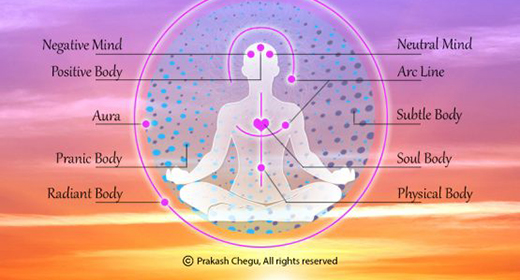by Enrique Collazo: Meditation teacher Enrique Collazo guides a practice for observing the wandering mind and allowing each thought to pass…
This practice is meant to help you become mindful of the mind as a process. Practicing awareness of the mind helps break our addiction to the contents of our mind. When we meditate on the mind as though it is a process, as though each thought is like a bubble floating, we can experience the spaciousness of awareness. We can practice allowing each thought we have to pass without getting into the thought bubble and floating away with it. Most importantly, we practice being patient and kind to ourselves as we explore this meditation.
A Guided Practice for Letting Thoughts Float by Like Bubbles
1. Find a way to sit that feels good and grounded. Adjust your posture so that your spine is erect without being rigid or stiff. Allow the rest of the body to be relaxed around the upright spine, maybe resting your hands in your lap or on your legs. Allow your eyes to gently close if you haven’t done so already. Bring full attention to the physical sensations of your sitting. Allow the breath to be natural.
2. Begin with a body scan. Scan from the crown of your head, all the way down to your toes, and as you scan through your body try to find any places where you are holding tension. See if you can soften and relax those areas, because you’ve probably been holding it for long enough. Begin at the crown of your head, making your way down, feeling every sensation and softening your forehead, the little muscles around your eyes, your jaw, and your tongue. Continue to scan down while relaxing your neck and shoulders. Continue down your body while feeling the rise and fall of your chest and abdomen. See if you can soften your belly, with each inhale and exhale softening it a little bit more. Make your way down the rest of your body, all the way down to your toes.
3. Feel where your body is supported. Next, see if you can feel into the places where your body makes contact, whether it’s with the ground, a chair, a couch, or whatever you’re sitting on. See if you can feel the sensations of your body being supported, the pressure and weight of your solidity, and all of the sensations that make up the experience of gravity in your body.
4. Bring your full attention to the present time and experience. Acknowledge the full range of what’s happening in this moment: Thinking is happening, hearing is happening, and seeing is happening (even if your eyes are closed). Tasting, smelling, physical sensations, and emotional sensations are all present. Allow all the experiences to be as they are, and redirect your attention to the sensation of your breath. Let your other senses fall to the background as you bring your awareness of the breath to the foreground.
Taking a Moment to Focus on the Breath
5. Allow your breath to find its own natural rhythm. You don’t have to breathe in a certain way. Take a moment to investigate where you feel the breath most easily, or where you feel contact with the breath. Typically, this will be in one or two places; for example, in the rising and falling of your belly, or on the tip of your nostril. Find where you feel it the most and see if you can post your attention there. For the next few minutes, choose that one place to stick with, while maintaining your attention on your breath. Feel the sensations of the air entering and exiting your body. Notice all of the sensations that make up the experience of breathing in your body.
6. Bring kindness to your practice. You may have already noticed that it is not so easy to keep sustained attention on an object, or on breath. In the beginning, while you’re training your mind in present time awareness of your breath, it’s really important to bring a quality of kindness and understanding to your practice. The mind is almost constantly wandering. See if you can try to be friendly toward your experience; of course your attention will wander. Try not to take it personally, as it’s not your fault. That’s what the untrained mind does. It will take time and perseverance to train the attention to stay with the chosen object of awareness.
7. Place your kind attention on the mind. With that same kind of understanding attention you’ve been meeting the breath with, see if you can meet your mind in the same way, and place your attention on the mind itself. As you observed your rising and falling breath, you observe the rising and passing of your thoughts. When working with the mind, it’s really helpful to allow the awareness to be expansive. Try not to get caught up in the contents of thoughts; let go of the need to solve any problems or make any plans. See if you can relax into the present time awareness of thoughts coming and going.
8. Try not to judge your wandering mind. Practicing this will begin to break the addiction to the contents of the mind, and break the identification with the mind. Meditate on the mind as though it is a process, as though each thought is like a bubble floating with the spaciousness of awareness. One bubble may contain plans, another may contain a memory, and another may contain a judgment or emotion. Allow each thought to pass without getting into the bubble or floating off with it. If you do become pulled into a thought or lost inside of a story, it’s not a big deal. It doesn’t matter where you went or how long you were there for, what matters most is how you return the attention back. Be patient and kind with yourself. Bring the attention back to awareness of the mind.
9. Observe the process of the mind. In the beginning of this practice you’re likely going to get seduced by thinking over and over again, floating off into a plan or a memory that feels too important to let pass. All of a sudden you may have what seems like a very important revelation or inspiration. This is just a natural process of the mind. As you continue to practice you will continue to change your relationship to this process, eventually becoming less and less compelled to follow a thread of thinking, especially when you’re meditating.
Allow each thought to pass without getting into the bubble or floating off with it. If you do become pulled into a thought or lost inside of a story, it’s not a big deal. It doesn’t matter where you went or how long you were there for, what matters most is how you return the attention back.
10. Notice what is happening in this moment. Whether you’re in your seat and your body watching the thoughts arise and pass away, or if you’ve gotten lost in a thought—Remember, if you’ve gotten lost in a thought it is not a big deal and is actually important to the process. Be easy on yourself. As soon as you notice this, you’re experiencing a moment of awakening. These moments of awakening are part of the goal. Once you notice that you’ve gotten lost in a thought, bring your attention back, and try to start over again. Whatever the object of meditation is, (whether it’s the breath, the body, a sound, or in this case the mind and thoughts), just continue to see the object for what it really is: just phenomena. Arising and passing, impersonal, impermanent phenomena.
11. Come back to the breath. Before you end your meditation practice, let go of the attention in the mind and bring your attention back into your body. Bring your attention back into the feeling of the contact points, feeling the ground, the solidity, and the weight, and open up to the sensations of your breathing. Feel your breath rising and falling. Notice whatever you feel like, and see if you can allow these feelings to just exist. Right now it’s like this.










































